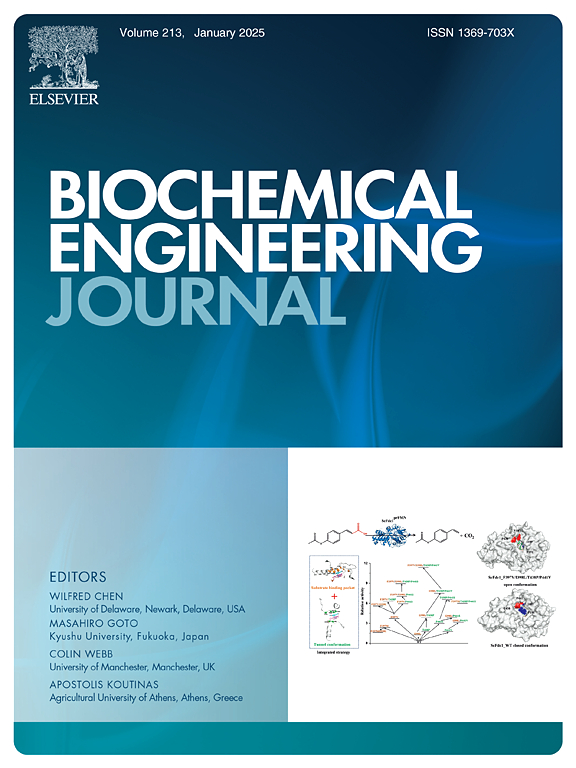Improvement of alka(e)ne production in Escherichia coli by the 3′-UTR engineering of acyl-ACP reductase
IF 3.7
3区 生物学
Q2 BIOTECHNOLOGY & APPLIED MICROBIOLOGY
引用次数: 0
Abstract
The sustainable and efficient production of biofuels has generated considerable interest in the microbial synthesis of alka(e)nes, which are promising alternatives to fossil fuels. Acyl-ACP reductase (AAR) is a critical enzyme in the alka(e)ne biosynthetic pathway, and its poor solubility in Escherichia coli is a major bottleneck during the optimization of production yields. The approaches for enhancing protein solubility typically include the fusion of solubility tags at the N- or C-termini of target proteins, which can sometimes interfere with protein function or stability. The present study developed a novel strategy that leverages the regulatory potential of 3′-untranslated regions (3′-UTRs) by integrating the sequence coding thioredoxin (Trx), small ubiquitin-like modifier (SUMO), maltose-binding protein (MBP), or N-utilization substance protein A (NusA), into the 3′-UTR of the AAR gene. The strategy aimed to enhance the stability of AAR mRNA for improving the solubility and expression of AAR without altering its primary structure. The findings revealed that this strategy significantly enhanced the solubility and expression levels of AAR in Escherichia coli, which markedly increased alka(e)ne production. This method has potential widespread applications in metabolic engineering and synthetic biology. The study paves the way for the development of more efficient strategies aimed at producing biofuels, and highlights the untapped potential of the 3′-UTR engineering strategy.
酰基acp还原酶3 ' -UTR工程提高大肠杆菌碱(e)ne产量
生物燃料的可持续和有效生产引起了人们对微生物合成碱(e)nes的极大兴趣,碱(e)nes是化石燃料的有希望的替代品。酰基- acp还原酶(Acyl-ACP reductase, AAR)是碱(e)ne生物合成途径中的关键酶,其在大肠杆菌中的溶解度较差是优化产量的主要瓶颈。提高蛋白质溶解度的方法通常包括在靶蛋白的N端或c端融合溶解度标签,这有时会干扰蛋白质的功能或稳定性。本研究开发了一种新的策略,通过将编码硫氧还蛋白(Trx)、小泛素样修饰子(SUMO)、麦芽糖结合蛋白(MBP)或n利用物质蛋白a (NusA)的序列整合到AAR基因的3 ' -UTR中,利用3 ' -非翻译区(3 ' -UTR)的调控潜力。该策略旨在增强AAR mRNA的稳定性,在不改变AAR初级结构的情况下提高AAR的溶解度和表达。结果表明,该策略显著提高了AAR在大肠杆菌中的溶解度和表达水平,从而显著提高了碱(e)ne的产量。该方法在代谢工程和合成生物学等领域具有广泛的应用前景。这项研究为开发更有效的生产生物燃料的策略铺平了道路,并强调了3 ' -UTR工程策略尚未开发的潜力。
本文章由计算机程序翻译,如有差异,请以英文原文为准。
求助全文
约1分钟内获得全文
求助全文
来源期刊

Biochemical Engineering Journal
工程技术-工程:化工
CiteScore
7.10
自引率
5.10%
发文量
380
审稿时长
34 days
期刊介绍:
The Biochemical Engineering Journal aims to promote progress in the crucial chemical engineering aspects of the development of biological processes associated with everything from raw materials preparation to product recovery relevant to industries as diverse as medical/healthcare, industrial biotechnology, and environmental biotechnology.
The Journal welcomes full length original research papers, short communications, and review papers* in the following research fields:
Biocatalysis (enzyme or microbial) and biotransformations, including immobilized biocatalyst preparation and kinetics
Biosensors and Biodevices including biofabrication and novel fuel cell development
Bioseparations including scale-up and protein refolding/renaturation
Environmental Bioengineering including bioconversion, bioremediation, and microbial fuel cells
Bioreactor Systems including characterization, optimization and scale-up
Bioresources and Biorefinery Engineering including biomass conversion, biofuels, bioenergy, and optimization
Industrial Biotechnology including specialty chemicals, platform chemicals and neutraceuticals
Biomaterials and Tissue Engineering including bioartificial organs, cell encapsulation, and controlled release
Cell Culture Engineering (plant, animal or insect cells) including viral vectors, monoclonal antibodies, recombinant proteins, vaccines, and secondary metabolites
Cell Therapies and Stem Cells including pluripotent, mesenchymal and hematopoietic stem cells; immunotherapies; tissue-specific differentiation; and cryopreservation
Metabolic Engineering, Systems and Synthetic Biology including OMICS, bioinformatics, in silico biology, and metabolic flux analysis
Protein Engineering including enzyme engineering and directed evolution.
 求助内容:
求助内容: 应助结果提醒方式:
应助结果提醒方式:


